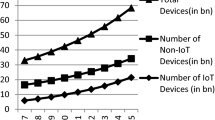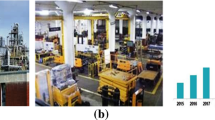Abstract
A most prominent and emerging technology namely the Internet of Things (IoT) enables legitimate users to access and monitor the sensors installed in various units of the industry. Such access and monitoring is facilitated using a secure authenticated key agreement (AKA) protocol. However, the complexity arises during the establishment of an effective session key agreement protocol to allow users to communicate securely with the sensors placed in the industrial IoT (IIoT). Few key agreement protocols existing in the literature have proved to perform the task effectively. Nevertheless, such protocols suffer from increased computation and communication cost. Hence, the motivation is to develop an efficient key agreement protocol that could over perform the existing protocols. Therefore, this research paper proposes an efficient key agreement protocol which is computationally and communication efficient. Moreover, the proposed key agreement protocol permits the users to securely communicate with the sensors. The proposed work focuses on twin dimensions. The first dimension is to reduce the computational complexity while sharing the mutual session key among the users and sensors. The second dimension focuses on decreasing the communicational cost. This is achieved by minimizing the amount of information communicated among the users and sensors. Subsequently, the proposed protocol is a hybrid methodology in which there are two working layers through which the session key is established. In the first layer, a mutual secret key is generated using a well-known elliptic curve cryptography (ECC) technique and this is shared among the users and the gateway node (GWN). In the second layer, the key generated in the above layer is used and the user initiates the key agreement process, wherein the GWN and sensors are generating a mutual session key using a group key. The simulated results of the proposed work clearly depicts the substantial reduction of computational and communicational complexities.





Similar content being viewed by others
References
Amin R, Biswas GP (2016) A secure light weight scheme for user authentication and key agreement in multi-gateway based wireless sensor networks. Ad Hoc Netw 36(1):58–80
Challa S, Wazid M, Das AK, Kumar N, Goutham Reddy A, Yoon E, Yoo K (2017) Secure signature-based authenticated key establishment scheme for future iot applications. IEEE Access 5(1):3028–3043
Chen C-M, Wang K-H, Yeh K-H, Xiang B, Tsu-Yang Wu (2019) Attacks and solutions on a three-party password-based authenticated key exchange protocol for wireless communications. J Ambient Intell Humaniz Comput 10:3133–3142
Choi Y, Lee D, Kim S, Jung J, Nam J, Won D (2014) Security enhanced user authentication protocol for wireless sensor networks using elliptic curves cryptography. Sensors 14(6):10081–10106
Hafizul Islam SK (2014) A provably secure ID-based mutual authentication and key agreement scheme for mobile multi-server environment without ESL attack. Wirel Pers Commun 79(3):1975–1991
Hafizul Islam SK, Biswas GP (2011) A more efficient and secure ID-based remote mutual authentication with key agreement scheme for mobile devices on elliptic curve cryptosystem. J Syst Softw 84(11):1892–1898
Hafizul Islam SK, Biswas GP (2012) A pairing-free identity-based authenticated group key agreement protocol for imbalanced mobile networks. Ann Telecommun 67(11–12):547–558
Hafizul Islam SK, Biswas GP (2013) Design of improved password authentication and update scheme based on elliptic curve cryptography. Math Comput Model 57(11–12):2703–2717
Hafizul Islam SK, Biswas GP (2015) Design of two-party authenticated key agreement protocol based on ECC and self-certified public keys. Wirel Pers Commun 82(4):2727–2750
Hassan A, Eltayieb N, Li F, Elhabob R, Li F (2018) An efficient certificateless user authentication and key exchange protocol for client-server environment. J Ambient Intell Humaniz Comput 9:1713–1727
He D, Ma M, Zeadally S, Kumar N, Liang K (2018) Certificateless public key authenticated encryption with keyword search for industrial internet of things. IEEE Trans Ind Inf 14(8):3618–3627
He D, Chen B, Libing Wu, Kumar N, Choo K-KR (2019) Lightweight searchable public-key encryption with forward privacy over IIoT outsourced data. IEEE Trans Emerg Top Comput. https://doi.org/10.1109/TETC.2019.2921113
He D, Zheng W, Lai C-F, Kumar N, Chen B (2020) Secure storage auditing with efficient key updates for cognitive industrial IoT environment. IEEE Trans Ind Inf. https://doi.org/10.1109/TII.2020.2991204
Kumar N, Amin R, Hafizul Islam SK, Biswas GP, Khan MK, Leng L (2016) Design of anonymity preserving three-factor authenticated key exchange protocol for wireless sensor network. Comput Netw 101(1):42–62
Kumar N, Challa S, Wazid M, Das AK, Reddy AG, Yoon E-J, Yoo K-Y (2017a) Secure signature-based authenticated key establishment scheme for future IoT applications. IEEE Access 5(1):3028–3043
Kumar N, Wazid M, Das AK, Odelu V, Conti M, Jo M (2017b) Design of secure user authenticated key management protocol for generic IoT networks. IEEE Internet Things J 5(1):269–282
Kumar N, Wazid M, Das AK, Odelu V, Susilo W (2017c) Secure remote user authenticated key establishment protocol for smart home environment. IEEE Trans Dependable Secure Comput 17(2):391–406
Kumar N, Das AK, Wazid M, Vasilakos AV, Rodrigues JJPC (2019) Biometrics-based privacy-preserving user authentication scheme for cloud-based industrial internet of things deployment. IEEE Internet Things J 5(6):4900–4913
Pairing-Based Cryptography [PBC] library [Online] (2006) http://crypto.stanford.edu/pbc/
Reddy AG, Shin JS, Das AK, Odelu V, Ahmad A (2019) A privacy preserving three-factor authenticated key agreement protocol for client–server environment. J Ambient Intell Humaniz Comput 10:661–680
Turkanovic M, Brumen B, Holbl M (2014) A novel user authentication and key agreement scheme for heterogeneous ad hoc wireless sensor networks based on the internet of things notion. Ad Hoc Netw 20:96–112. https://doi.org/10.1016/j.adhoc.2014.03.009
Vijayakumar P, Bose S, Kannan A, Jegatha Deborah L (2013) Computation and communication efficient key distribution protocol for secure multicast communication. KSII Trans Internet Inf Syst 7(4):878–894
Vijayakumar P, Bose S, Kannan A (2014) Chinese remainder theorem based centralized group key management for secure multicast communication. IET Inf Secur IET 8(3):179–187
Vijayakumar P, Wei F, Jiang Qi, Zhang R (2018a) A mobile intelligent terminal based anonymous authenticated key exchange protocol for roaming service in global mobility networks. IEEE Trans Sustain Comput 5(2):268–278
Vijayakumar P, Wei F, Shen J, Zhang R, Li Li (2018b) A provably secure password-based anonymous authentication scheme for wireless body area networks. Comput Electr Eng 65(1):322–331
Vinoth R, Deborah LJ, Vijayakumar P, Kumar N (2020) Secure multi-factor authenticated key agreement scheme for industrial IoT. IEEE Internet Things J. https://doi.org/10.1109/JIOT.2020.3024703,Acceptedforpublication
Wazid M, Das AK, Odelu V, Susilo W, Kumar N, Conti M, Jo M (2017) Design of Secure user authenticated key management protocol for generic iot networks. IEEE Internet Things J 5(1):269–282
Wei F, Zhang R (2018) A provably secure anonymous two-factor authenticated key exchange protocol for cloud computing. Fundam Inf 157(1–2):201–220
Zhang Y, Jia Yu, Hao R, Wang C, Ren K (2018) enabling efficient user revocation in identity-based cloud storage auditing for exchanged big data. IEEE Trans Dependable Secure Comput 17(3):608–619
Author information
Authors and Affiliations
Corresponding author
Additional information
Publisher's Note
Springer Nature remains neutral with regard to jurisdictional claims in published maps and institutional affiliations.
Rights and permissions
About this article
Cite this article
Vinoth, R., Deborah, L.J. An efficient key agreement and authentication protocol for secure communication in industrial IoT applications. J Ambient Intell Human Comput 14, 1431–1443 (2023). https://doi.org/10.1007/s12652-021-03167-z
Received:
Accepted:
Published:
Issue Date:
DOI: https://doi.org/10.1007/s12652-021-03167-z




